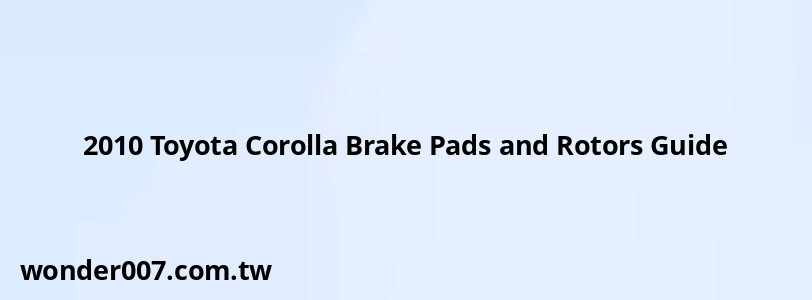2010 Toyota Corolla Brake Pads and Rotors Guide

The 2010 Toyota Corolla requires regular maintenance of its brake system, including the replacement of brake pads and rotors. This guide will provide essential information for owners and mechanics looking to perform this crucial maintenance task.
Brake System Overview
The 2010 Toyota Corolla features a disc brake system on the front wheels, which consists of brake pads and rotors. The rear may have either disc or drum brakes, depending on the specific model. Regular inspection and replacement of these components are vital for maintaining optimal braking performance and safety.
Front Brake Specifications
- Rotor diameter: 10.8 inches (275mm)
- Original rotor thickness: 22mm
- Minimum rotor thickness: 19mm
- Brake pad type: Ceramic or semi-metallic
Replacement Process
Replacing the brake pads and rotors on a 2010 Toyota Corolla involves several steps:
1. Wheel removal: Loosen the lug nuts and safely lift the vehicle.
2. Caliper removal: Use a 14mm socket to remove the caliper bolts.
3. Brake pad removal: Slide out the old brake pads.
4. Rotor removal: If replacing, remove the rotor after taking off the caliper bracket.
5. Surface preparation: Clean the hub surface and new rotor with brake cleaner.
6. New rotor installation: Place the new rotor onto the hub.
7. Caliper bracket reinstallation: Secure with 17mm bolts.
8. New pad installation: Insert new brake pads into the caliper bracket.
9. Caliper reinstallation: Compress the piston and reattach the caliper.
10. Final checks: Ensure all components are properly secured.
Important Considerations
- Always replace brake pads in pairs (both wheels on the same axle).
- Inspect the brake fluid level and top up if necessary.
- Check the condition of brake lines and hoses during the replacement process.
- Apply brake grease to the caliper sliding pins to ensure smooth operation.
Choosing Replacement Parts
When selecting new brake pads and rotors for your 2010 Toyota Corolla, consider the following:
- OEM vs. aftermarket: OEM parts ensure perfect fit but may be more expensive.
- Brake pad material: Ceramic pads offer low dust and noise, while semi-metallic provide better performance.
- Rotor type: Standard, drilled, or slotted rotors are available, each with different benefits.
| Rotor Type | Benefits |
|---|---|
| Standard | Cost-effective, suitable for daily driving |
| Drilled | Better heat dissipation, improved wet braking |
| Slotted | Enhanced pad bite, reduced gas buildup |
Maintenance Tips
To extend the life of your brake system:
- Avoid aggressive braking when possible.
- Regularly clean brake dust from wheels to prevent corrosion.
- Perform brake fluid flush every 2 years or 30,000 miles.
- Address any unusual noises or vibrations promptly.
By following these guidelines and performing regular maintenance, you can ensure that your 2010 Toyota Corolla's brake system remains in optimal condition, providing reliable stopping power and safety for years to come.
Related Posts
-
2009 Nissan Murano Key Fob Programming Guide
28-01-2025 • 157 views -
Windshield Washer Nozzle: Repair Guide for 2010 Ford Focus
30-01-2025 • 165 views -
Jeep Grand Cherokee Seat Heater Troubleshooting Guide
30-01-2025 • 183 views -
Dodge Ram 1500: Comprehensive Engine Guide for 2004
29-01-2025 • 169 views -
Bluebird Bus Dash Warning Lights: Essential Guide
26-01-2025 • 304 views
Latest Posts
-
Power Steering Fluid Leak On Passenger Side
01-02-2025 • 419 views -
2015 Chevy Traverse AC Recharge Port Location
01-02-2025 • 365 views -
Rear Brake Caliper Piston Won't Compress
01-02-2025 • 312 views -
Are O2 Sensors Covered Under Warranty
01-02-2025 • 338 views -
How To Turn Off Paddle Shifters Mercedes
01-02-2025 • 333 views
Popular Posts
-
Power Steering and ABS Light On: Causes and Solutions
27-01-2025 • 610 views -
V12 Engine Costs: What You Need to Know
26-01-2025 • 629 views -
EPC Warning Light: What It Means for Your Vehicle
27-01-2025 • 590 views -
EPC Light: Understanding Causes and Solutions
26-01-2025 • 1019 views -
Hino Warning Lights: Understanding Dashboard Alerts
26-01-2025 • 632 views
